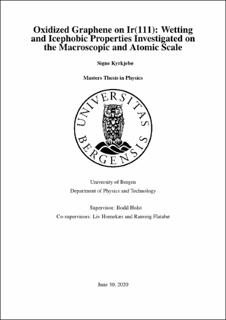| dc.description.abstract | Icing remains a huge challenge in a wide range of industries, from airplanes to optical sensors and wind turbines. Today's ice-combating approaches include thermal, mechanical, and chemical methods, which come with power, cost, and environmental drawbacks. The development of an icephobic coating, which is a coating that repels ice formation, will have huge advances. The lightweight, durability, and optical transparency of graphene, a 2D carbon material, makes it an interesting material for coatings. Graphene oxide is one of the most common graphene derivatives. Chemically synthesized graphene oxide is hydrophilic and has been predicted to have superior icephobic properties. A new type of oxidized graphene was discovered on Ir(111) in 20018, where the dominating functional group on the basal plane is enolates. This thesis work presents the first study of the wetting and icephobic properties of oxidized graphene on Ir(111). Two O-Gr/Ir(111) samples with low ($\sim$ 8 \%) and high (saturated) oxygen coverage, were prepared and characterized in ultra-high vacuum by scanning tunneling microscopy and x-ray photoelectron spectroscopy. These samples are referred to as the low- and high-coverage sample throughout this thesis. The icephobic and wetting surface properties of O-Gr/Ir(111) were studied under ambient conditions by measuring the water contact angles, the freezing onset temperature, and the freezing delay times. The sample with saturated oxygen coverage was characterized by scanning tunneling microscopy and x-ray photoelectron spectroscopy after the icing experiments to investigate the durability of the coating on the atomic level. The results show that oxidized graphene on Ir(111) is almost hydrophobic under ambient conditions with a water contact angle of $71 ^\circ \pm 5 ^\circ$ and $77 ^\circ \pm 6 ^\circ$ for the low- and high-coverage sample, respectively. The water contact angle is similar to that of bare Ir(111) and appears to be independent of the oxygen coverage indicating that oxidized graphene on Ir(111) is transparent to wetting. The freezing onset temperature is found to be $-18 ^\circ$C $\pm 1^\circ$C and $-21 ^\circ$C $\pm 1^\circ$C for the low- and high-coverage sample, respectively. Thus, the freezing onset temperature appears to decrease with increasing oxygen coverage. The surface analysis after the icing experiments show that oxygen species and/or water intercalates through graphene edges between the graphene layer and the Ir(111) substrate, accompanied by the loss of oxygen-containing functional groups. An article on the basis of these results will be submitted to Carbon, and is included in the Appendix B.2. | |
